Meet Shigeru Ban, Winner of the 2014 Pritzker Architecture Prize
http://decor-ideas.org 03/26/2014 01:23 Decor Ideas
Considered the Nobel Prize of architecture, the annual Pritzker Architecture Prize is given by Chicago’s Hyatt Foundation. It honors a living architect (or architects) whose built work demonstrates a combination of talent, vision and commitment, someone who has produced consistent and significant contributions to humanity and the built environment through the art of architecture. The 2014 winner is Japanese architect Shigeru Ban.
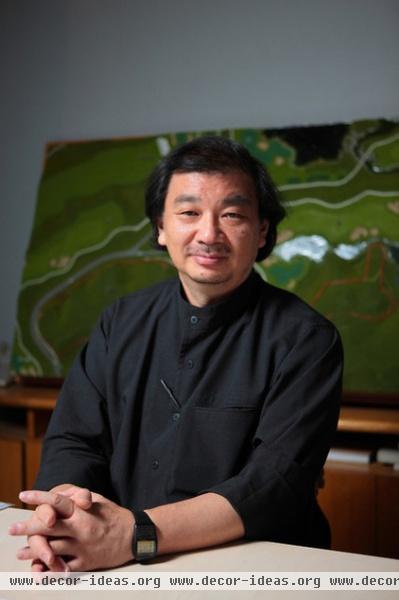
The official announcement lauds Ban’s “elegant, innovative work for private clients, and … the same inventive and resourceful design approach for his extensive humanitarian efforts.” Many of the former include high-end residences in his native Japan, but also as far as New York City, while his humanitarian efforts are focused on refugee and disaster housing and other types of buildings in the places that need it most, be it Japan after the March 2011 earthquake or other parts of the world.
I’m reminded of the architect’s words at an opening of a store he designed in New York’s fashionable SoHo district in 2012, when he said that all design work is equal for him, whether it’s a store, a house or refugee housing. He approaches all types of buildings with the same creativity — as we’ll see, different material choices arise from different budgets — which is one reason Ban deserves the Pritzker, architecture’s highest honor.
In recent years the buildings Ban has completed are much larger in scale than single houses — most notably a branch of the Centre Pompidou-Metz in France and a seven-story office building in Zurich framed with timber (but no screws, bolts or glue!).
Nevertheless he continues with his humanitarian efforts. Last year he completed a temporary cathedral in Christchurch, New Zealand, a couple of years after it was hit by an earthquake.
It’s not surprising that he is humble. “Receiving this prize is a great honor, and with it, I must be careful,” he says. “I must continue to listen to the people I work for, in my private residential commissions and in my disaster relief work. I see this prize as encouragement for me to keep doing what I am doing — not to change what I am doing, but to grow.”
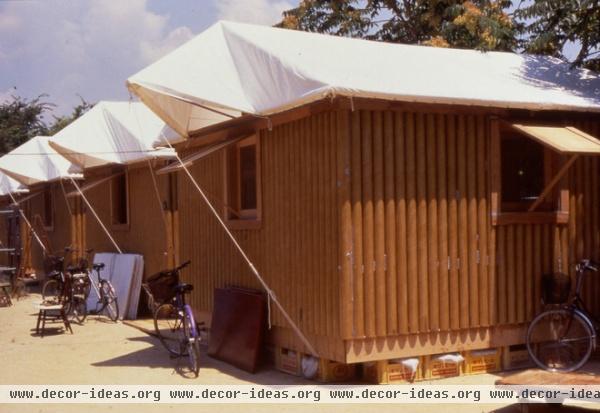
Ban’s first humanitarian efforts were in response to the conflicts in Rwanda in 1994, when he proposed paper-tube structures to the United Nations High Commissioner for Refugees. Cardboard tubes, typically used as formwork for concrete footings, were envisioned in an entirely different way, as the main structure for framing temporary dwellings. Inexpensive and easy to erect, they were ripe for broader use and experimentation. These first structures came four years after Ban first explored the technical limits of building with cardboard, meaning the relief housing was part of a developing process that looked at the ability to use a material before a canvas for its use had been determined.
One year later, when an earthquake hit Kobe, Japan, Ban responded with the Paper Log Houses, shown here, where paper tubes are structure and enclosure, sitting atop beer crates weighted down with sandbags.
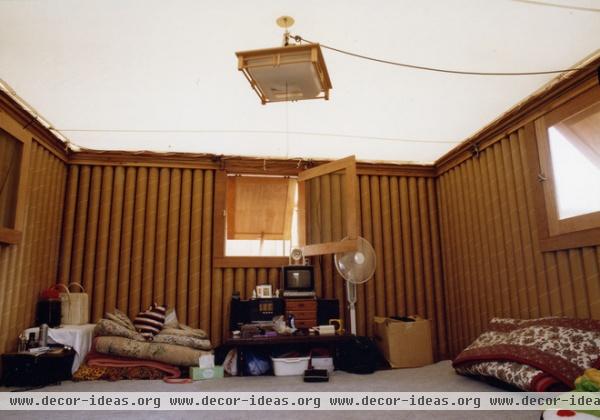
These one-room dwellings are simple, but they’re a huge improvement over the norm, particularly tents that were smaller and could not withstand the elements as well. The fabric ceiling illuminates the interior beautifully, while the windows allow for cross ventilation.
The same year of the Paper Log Houses, Ban created the Voluntary Architects’ Network (VAN), a nongovernmental organization devoted to quick and creative responses to disasters. Rather than applying the same design as in Kobe to each disaster, Ban and his team considered the materials locally available, the skills of people in the area and the direct needs of those involved; these traits have led to diverse structures that each have their own sort of beauty.
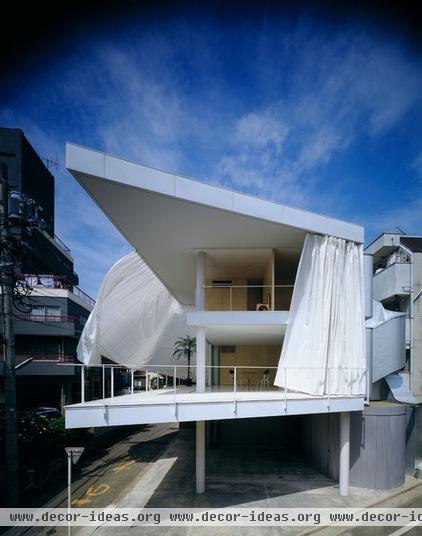
To compare and contrast the two poles of Ban’s work, here is a look at the Curtain Wall House in Tokyo, also completed in 1995. The house’s name refers to the glass walls that have become ubiquitous in modern offices and other buildings around the world in the past 50 years. But his take on it is playful, as two-story curtains sit in front of the sliding glass walls that enclose the rooms.
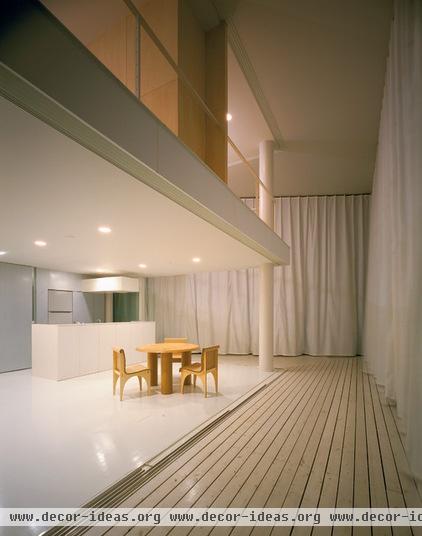
While thoroughly simple and modern, the two sliding layers are rooted in the traditional Japanese shoji screens that separate rooms and the engawa, which is a zone between the outside and inside of a building.
This interior view shows how much the curtains can create a strong sense of enclosure, even with the glass walls all the way open. Note the chairs, designed by Ban from cardboard tubes.
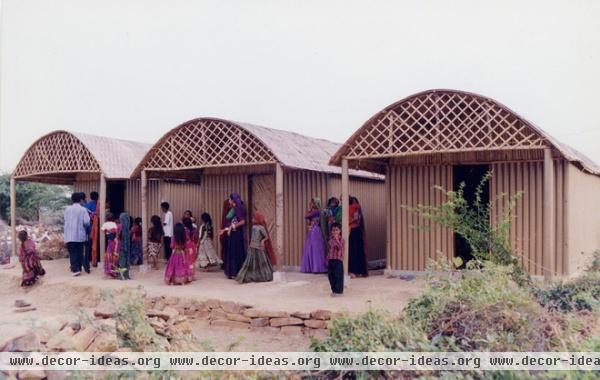
A variation on the Kobe Paper Log Houses can be seen in these houses built in India in 2001. Variation comes in the form of the roofs, which utilize locally abundant mats and extend beyond the cardboard-tube walls to create small porches. Less obvious is the foundation. Due to the location, an alcohol-free Muslim area, the architect used rubble from destroyed buildings rather than the beer crates he used in Japan.
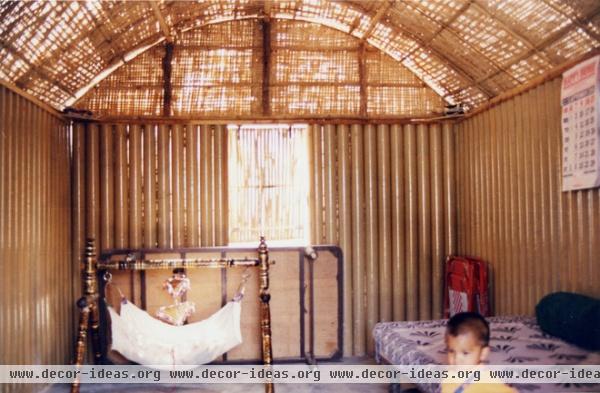
The mats framed by bamboo give the one-room interiors a different feel than the rooms in Kobe, filtering the sunlight while also allowing for ventilation.
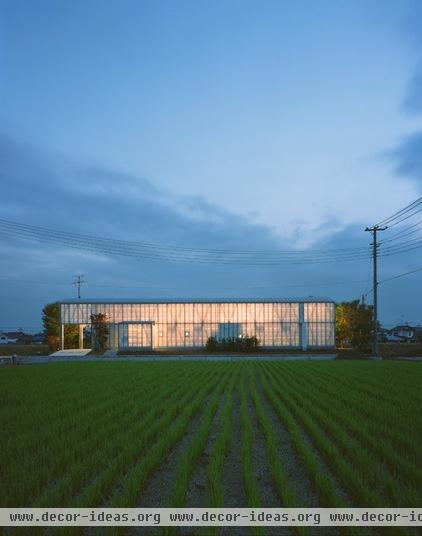
Filtered sunlight is also evident in the Naked House he designed for a three-generation household in an agricultural region near Tokyo. Completed in 2000, the house glows from within thanks to translucent exterior walls.
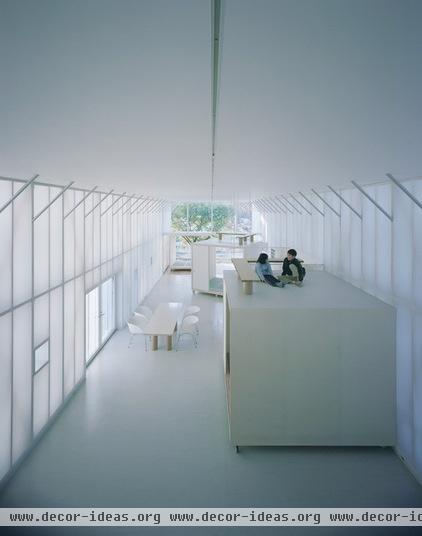
Inside, the long, double-height building is an expression of the multigenerational family who lives there. Rooms raised on casters can be moved around the loft-like space and separated from the rest of the space via curtains. The position of the boxes impacts the shape of the communal space, making it a dynamic design much like the Curtain Wall House.
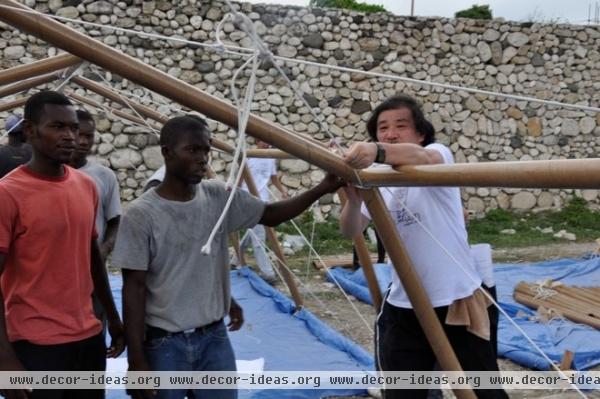
While Ban has become known for his “paper architecture,” his disaster relief housing takes many forms. Here we see the architect working in Haiti in 2010 on cardboard-tube structures that will be covered in blue tarp …
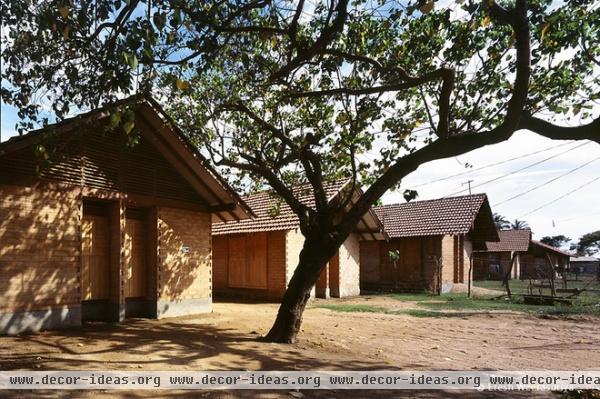
… but in Sri Lanka in 2007, he designed posttsunami dwellings built from compressed-earth blocks.
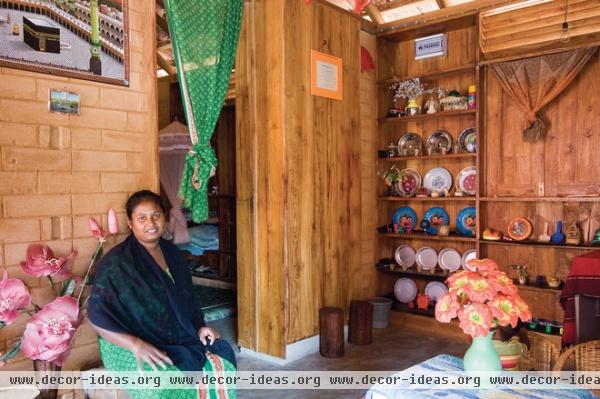
Rubber trees were used for the interior, an atypical application but one that made sense, given the tire industry in Sri Lanka.
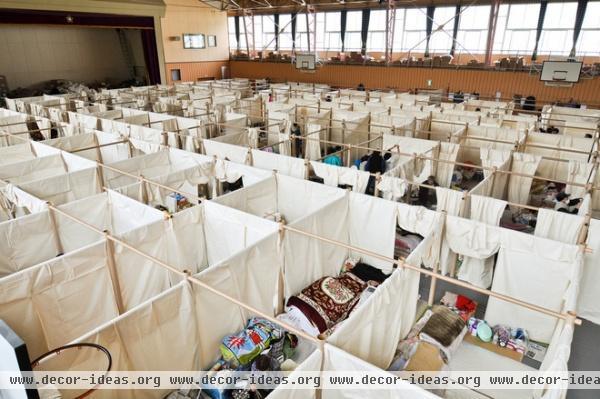
Ban took particularly diverse routes after the 2011 earthquake in Japan. His main response focused on creating privacy in the gymnasiums where many of the displaced people were forced to take shelter. Simple cardboard-tube frames hung with paper curtains allowed individuals and families to maintain some private space, reducing the physical and mental damage often associated with such high-density temporary living conditions.
Here we see Ban borrowing an idea from his earlier Curtain Wall House. The Paper Partition System is so well suited to its circumstances that it’s one design that should be exported to other locales, given how gyms are commonly used by the Red Cross and other agencies after disasters.
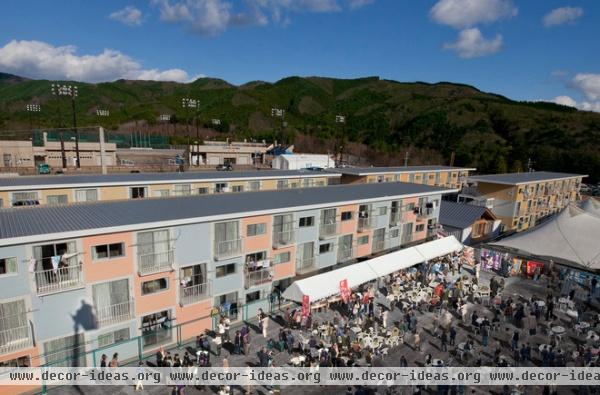
While working on the Paper Partition System, Ban responded to the shortage of temporary housing in Onagawa, Japan, destroyed by the 2011 tsunami. He designed temporary housing made from shipping containers stacked three stories high. The checkerboard pattern creates open living spaces between units.
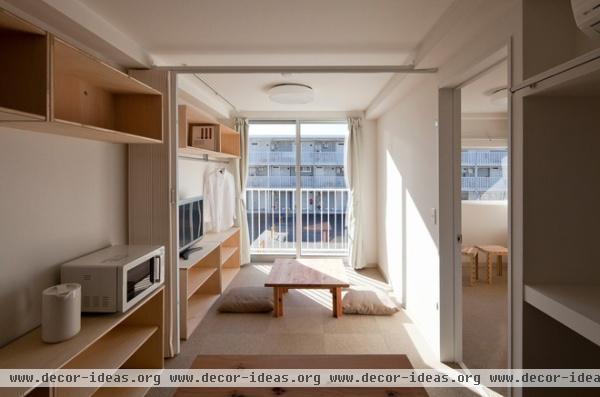
These units are more modern than the Paper Log Houses, but are also generated by local materials and skills.
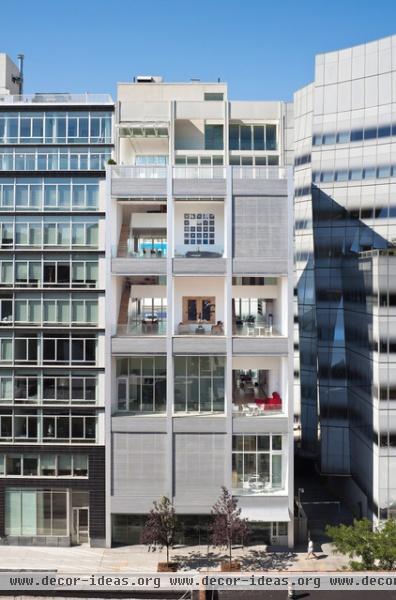
Ban’s commissions have diversified and grown in scale over the years. He is designing museums and office buildings these days, not just houses and temporary housing and the occasional church. For a recent project in New York City, he took some ideas from his houses in Japan — his contemporary interpretations of shoji screens and engawa, in particular — and applied them to stacked duplex residences. The Metal Shutter Houses are appropriately covered with retractable shutters that open the two-story apartments to the street.
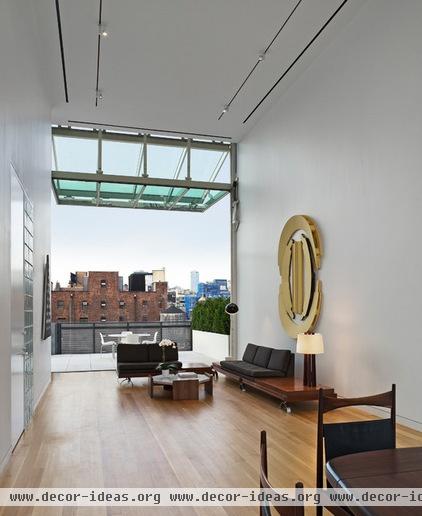
An inside layer of glass folds up to open the residence to the city. Reminiscent of the Curtain Wall House, the project finds its expression in the New York City vernacular of metal shutters and retractable garage doors, elevated to a fine level of detail appropriate to multimillion-dollar apartments.
Compare this photo to the shipping containers he designed for Onagawa, and we can see that Ban does treat these two poles of his work similarly. The materials, scale and details vary, but each one is appropriate to its circumstances and overtly aware of the people who will live there. This is humanitarian architecture par excellence.
Meet more Pritzker winners
Related Articles Recommended












